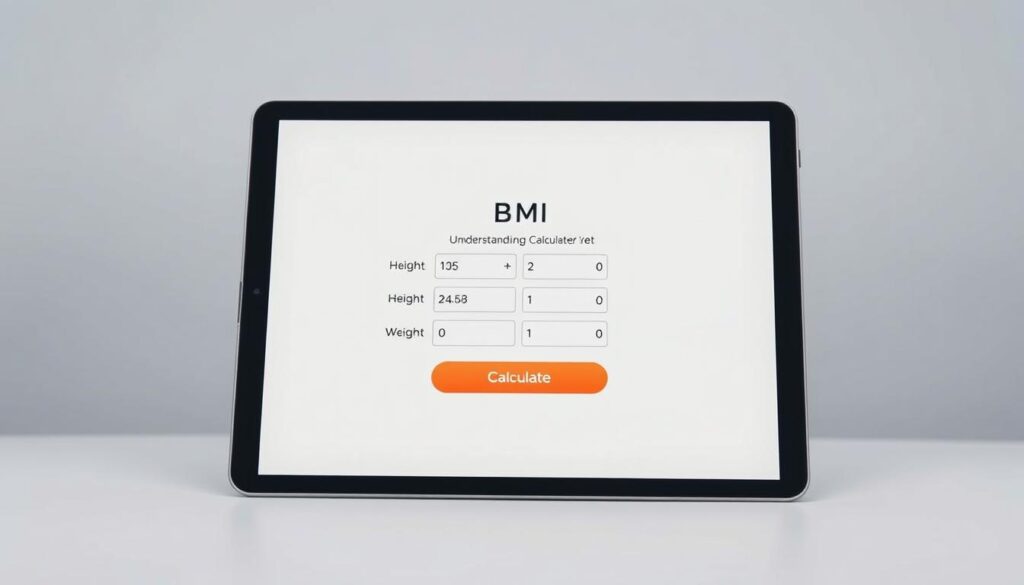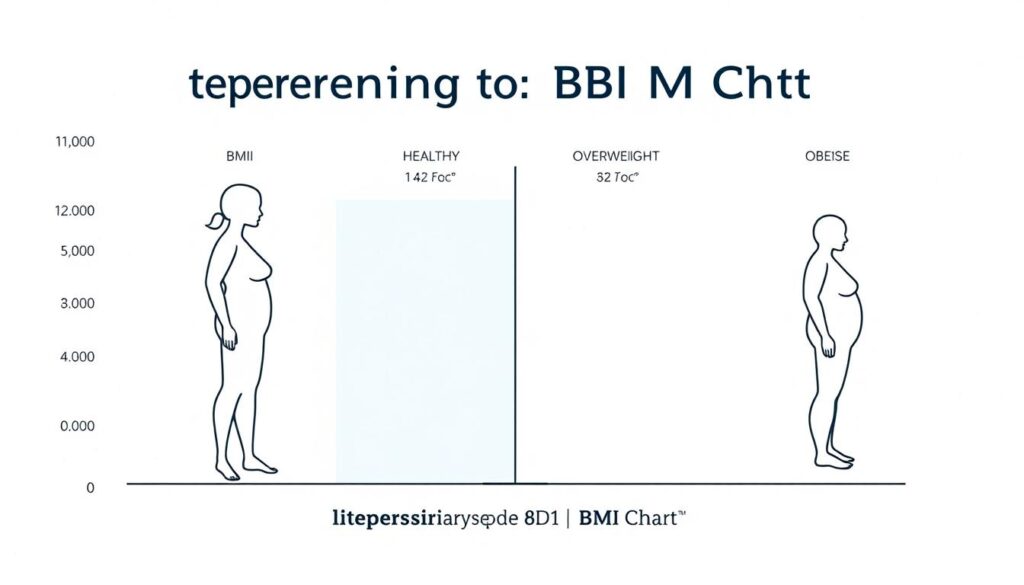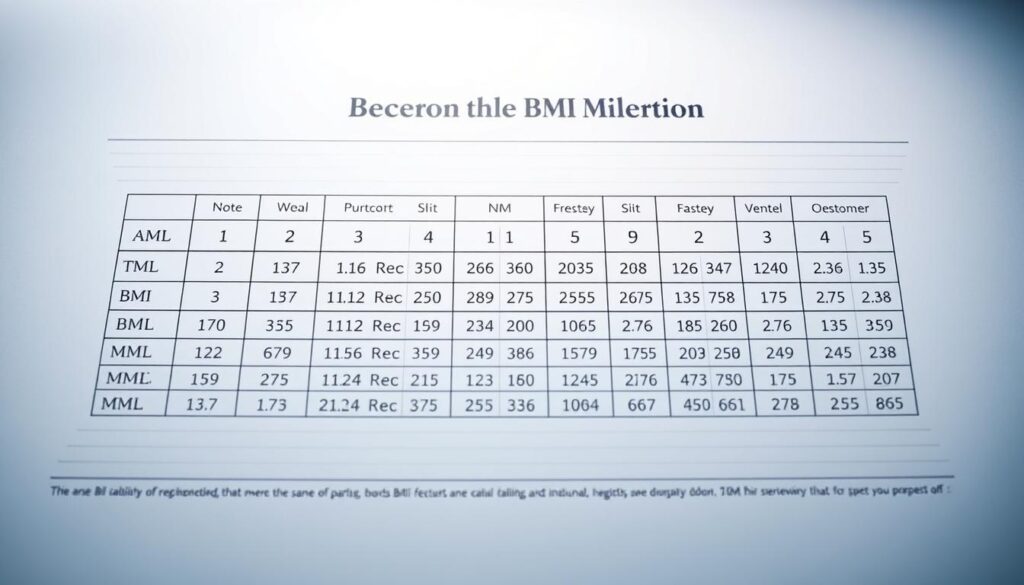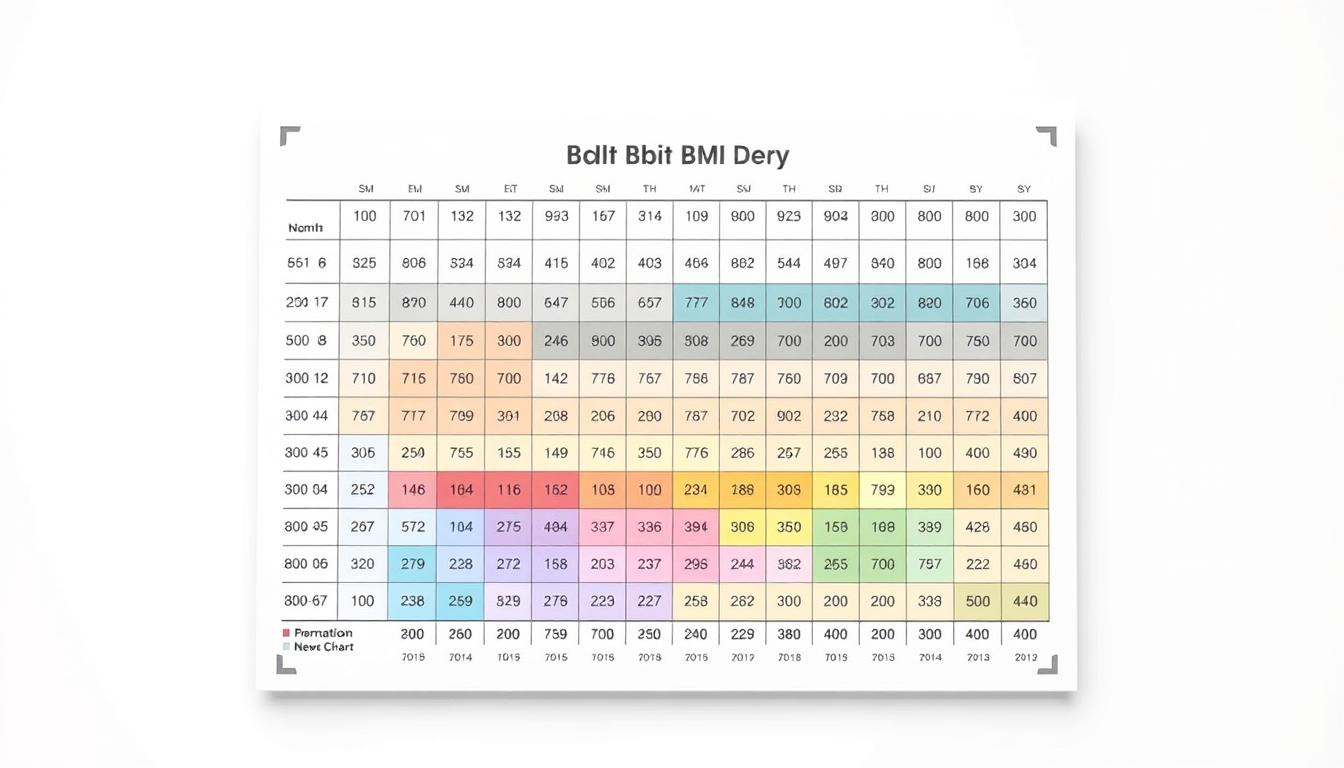Do you know your body mass index and what it means for your health?
A BMI chart is a simple tool to check if you’re underweight, at a healthy weight, overweight, or obese. The CDC says BMI is a way to measure your weight compared to your height.
We’ll look into how BMI is used as a health indicator. We’ll also see what each category means for your health.
Key Takeaways
- Knowing your BMI category is key to understanding your health risks.
- A body mass index chart makes it easy to see your weight status.
- The CDC divides BMI into underweight, healthy weight, overweight, and obesity.
- Staying at a healthy weight can lower your risk of many health problems.
- Using a BMI chart is a simple way to keep an eye on your health.
Understanding BMI: What It Is and Why It Matters
BMI is more than just a number; it’s a gateway to understanding our body’s health landscape. Body Mass Index, or BMI, is a simple yet effective tool used globally to assess weight status and potential health risks.
Definition of BMI
At its core, BMI is a measurement that uses a person’s height and weight to estimate their body fat. It’s defined as the body mass (in kilograms) divided by the square of the body height (in meters). This definition is crucial because it forms the basis of how BMI is used in health assessments.
How BMI Is Calculated
To calculate BMI, you divide an adult’s weight in kilograms by their height in meters squared. For instance, if a person weighs 70 kilograms and is 1.75 meters tall, their BMI would be 22.86 (70 kg / (1.75 m)^2). This calculation is straightforward and can be done using a BMI calculator for convenience.

Importance of BMI in Health Assessment
BMI serves as a vital tool in health assessments because it provides a quick and inexpensive way to screen for weight categories that may lead to health problems. According to health professionals, understanding your BMI can be the first step towards managing your weight and reducing the risk of chronic diseases like diabetes and heart disease. By knowing your BMI, you can take proactive steps towards a healthier lifestyle.
It’s worth noting that while BMI is not a perfect measure, it is widely used due to its simplicity. For a more accurate assessment, healthcare professionals often consider additional factors alongside BMI.
Interpreting the BMI Chart
The BMI chart is a simple tool for checking weight status and health risks. It helps us understand different weight categories and ranges.
BMI Categories Explained
The World Health Organization has defined BMI categories: underweight (BMI
Dr. Margaret Ashwell, a renowned obesity expert, said, “BMI is a useful indicator of whether someone is at a healthy weight for their height, but it is not a perfect measure.” This shows why it’s key to know BMI’s limits.
Visual Representation of BMI Ranges
 BMI charts use colors to show different categories. This helps you see if you’re underweight, normal weight, overweight, or obese.
BMI charts use colors to show different categories. This helps you see if you’re underweight, normal weight, overweight, or obese.
Common Misconceptions about BMI
Many think BMI directly measures health. But, BMI is just an indicator and doesn’t tell the difference between lean body mass and body fat. The Centers for Disease Control and Prevention say, “BMI is not a diagnostic tool but rather a screening tool to identify potential health risks.”
- BMI does not account for muscle mass.
- It may not be accurate for athletes or individuals with a muscular build.
- BMI can be misleading for older adults or those with a lot of body fat but normal weight.
Knowing these limitations is key for a better understanding of the BMI chart.
Factors Influencing BMI
It’s important to know what affects BMI. BMI is useful but not perfect. Many things can change an individual’s BMI, so it’s key to consider these when looking at health risks.
Age and Gender Considerations
Age and gender greatly impact BMI. As we get older, our body composition changes. This can lead to more body fat and less muscle. For example, older adults might have more body fat for the same BMI as younger people.
Gender also matters. Women usually have more body fat than men at the same BMI.
Key age and gender considerations include:
- Changes in body composition with age
- Differences in body fat distribution between genders
- The impact of hormonal changes on body composition
Muscle Mass vs. Fat Mass
BMI doesn’t measure body fat directly. It looks at weight compared to height. So, athletes with a lot of muscle might have a high BMI without being overweight. For example, a football player might be seen as obese due to muscle, not fat.

This distinction is crucial because it shows BMI’s limits. Athletes or those with a lot of muscle might need more tests, like body fat percentage, to truly understand their health.
Ethnicity Impact on BMI
Ethnicity also affects BMI interpretation. Different ethnic groups have different body compositions and fat distribution. For example, people of Asian descent might face health risks at a lower BMI than those of European descent.
Ethnicity-related factors to consider:
- Body composition differences among ethnic groups
- Variations in fat distribution patterns
- The need for ethnicity-specific BMI categories
Knowing these factors helps us use BMI better. It’s part of a full health check, along with other measurements, to truly understand someone’s health.
Limitations of BMI
BMI is a common tool, but it has its downsides. It looks at weight and height but doesn’t tell us about body fat or muscle.
Why BMI Isn’t Always Accurate
BMI might not show a person’s true health. Athletes with lots of muscle can have a high BMI but not be overweight. Older adults might have a low BMI because of muscle loss, even with a lot of body fat.
Cases Where BMI May Mislead
BMI can be misleading in some cases. People with a lot of muscle might be seen as overweight or obese, even if they’re not. It also doesn’t look at body fat distribution, which is key to health risks.
Alternative Measurements of Health
There are better ways to measure health than BMI. Waist circumference, waist-to-hip ratio, and body fat percentage give a clearer picture. They help spot health risks, even if BMI looks okay.
Knowing BMI’s limits and using other measures helps doctors give better advice. By looking at more than just BMI, we can understand health better. This leads to better health outcomes for everyone.
How to Use the BMI Chart Effectively
A BMI chart is more than just a number. It’s a tool that can give you valuable insights into your health. To get the most out of it, you need to know how to use and understand the information it provides.
Steps to Calculate Your BMI
Calculating your BMI is easy. You can use an online BMI calculator or do it manually. The formula is weight in kilograms divided by height in meters squared. Make sure your measurements are accurate for a correct calculation.
For example, if you weigh 70 kg and are 1.75 meters tall, your BMI is 22.86. This is found by dividing 70 by (1.75)^2.
Using BMI Charts for Personal Goals
After finding your BMI, you can set health and weight goals. If your BMI shows you’re underweight or overweight, talk to a healthcare professional. They can help you make a plan that fits your needs.
If your BMI says you’re overweight, you might want to lose weight. This could mean eating healthier and exercising more.
| BMI Category | BMI Range | Health Risk |
|---|---|---|
| Underweight | Less than 18.5 | High |
| Normal weight | 18.5 – 24.9 | Low |
| Overweight | 25 – 29.9 | Moderate |
| Obese | 30 or greater | High |
Consulting with Health Professionals
While BMI charts are helpful, they’re just one tool. Talking to healthcare professionals gives you a better view of your health.
They can give you advice tailored to your BMI, health, and other factors. This includes muscle mass and body composition.
BMI and Weight Management
It’s important to know how BMI affects weight management. Keeping a healthy weight is key for good health. BMI helps set realistic weight goals.
Setting Realistic Weight Goals
Setting achievable weight goals is crucial. BMI categories help understand your weight status and ideal range. For example, a BMI of 18.5 to 24.9 is considered normal. Using a body mass index chart can show your progress and guide your goals.
| BMI Category | BMI Range | Weight Status |
|---|---|---|
| Underweight | Less than 18.5 | Potential health risks |
| Normal weight | 18.5 – 24.9 | Low risk |
| Overweight | 25 – 29.9 | Moderate risk |
| Obese | 30 or greater | High risk |
Healthy Weight Loss Strategies
Reaching a healthy weight is more than dieting. It’s about making lasting lifestyle changes. Incorporating regular physical activity and a balanced diet are essential. Also, tracking your progress with BMI is important.
The Role of Diet and Exercise
Diet and exercise are vital for weight management. Eat lots of fruits, veggies, whole grains, and lean proteins. Regular exercise burns calories and builds muscle, boosting health and metabolism.
Understanding your BMI and making smart diet and exercise choices can help manage your weight. This improves your overall health.
Infographics: Visual Learning Tools
Infographics make learning about BMI and health risks fun and easy. They show complex info in a simple way. This helps us understand and use this info for our health goals.
Infographic1: How to Read a BMI Chart
Using a BMI chart right is key. An infographic can show you how to calculate your BMI and what it means. It breaks down BMI ranges and explains their health effects.
- Understand the BMI scale and its categories
- Learn how to plot your BMI on the chart
- Interpret your BMI category and associated health risks
Infographic2: BMI and Health Risks
Infographics also show health risks tied to BMI categories. They make complex data simple. For example, they might show how high BMI can lead to diseases like diabetes and heart disease.
- Visualize the health risks associated with different BMI categories
- Understand the implications of your BMI on overall health
- Take proactive steps to manage your weight and reduce health risks
Using infographics helps us grasp health data better. It empowers us to manage our health and well-being.
Resources for Tracking Your BMI
Keeping a healthy BMI is key for your overall health. There are many online tools to help you track your BMI. You can find out your BMI category using simple guidelines: Underweight (BMI
Online BMI Calculators
Online BMI calculators make it easy to check your BMI. For example, you can use the BMI calculator to find out your BMI right away. This helps you understand your weight status.
Apps for Health Monitoring
There are many health apps that track your BMI and other important health metrics. These apps give you a full view of your health. They help you reach your fitness goals and keep a healthy BMI.
Community Support Groups and Programs
Being part of community support groups and programs is very helpful. These resources offer advice, motivation, and a sense of belonging. They help you reach and keep a healthy BMI through lasting lifestyle changes.


